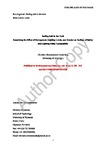Feeling Safe in the Dark : Examining the Effect of Entrapment, Lighting Levels, and Gender on Feelings of Safety and Lighting Policy Acceptability
| dc.contributor.author | Boomsma, C | en |
| dc.contributor.author | Steg, L | en |
| dc.date.accessioned | 2014-09-10T15:38:30Z | |
| dc.date.available | 2014-09-10T15:38:30Z | |
| dc.date.issued | 2014-02-01 | en |
| dc.identifier.uri | http://hdl.handle.net/10026.1/3102 | |
| dc.description.abstract |
This research examined to what extent physical factors, notably lighting and entrapment (blocked escape), and individual factors, notably gender, affect feelings of safety and the acceptability of reduced lighting levels. The authors reasoned that acceptability of reduced street lighting depends on perceived safety, which in turn depends on entrapment, lighting, and gender. Virtual representations of a residential street were used, systematically manipulating entrapment and lighting levels. As expected, people felt less safe in lower lighting and higher entrapment settings, and these settings were evaluated as less acceptable. Although women perceived a situation as less safe compared with men, the authors found no gender differences in acceptability, which extends previous research. Importantly, as hypothesized, perceived safety mediated the effect of lighting on acceptability levels, suggesting that people can accept lower lighting levels when social safety is not threatened. | en |
| dc.format.extent | 193 - 212 | en |
| dc.language.iso | en | en |
| dc.title | Feeling Safe in the Dark : Examining the Effect of Entrapment, Lighting Levels, and Gender on Feelings of Safety and Lighting Policy Acceptability | en |
| dc.type | Journal Article | |
| plymouth.issue | 2 | en |
| plymouth.volume | 46 | en |
| plymouth.publication-status | Published | en |
| plymouth.journal | Environment and Behavior | en |
| dc.identifier.doi | 10.1177/0013916512453838 | en |
| plymouth.organisational-group | /Plymouth | |
| dc.rights.embargoperiod | Not known | en |
| rioxxterms.versionofrecord | 10.1177/0013916512453838 | en |
| rioxxterms.licenseref.uri | http://www.rioxx.net/licenses/all-rights-reserved | en |
| rioxxterms.type | Journal Article/Review | en |


